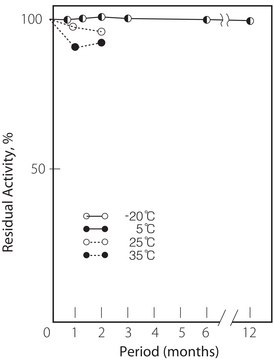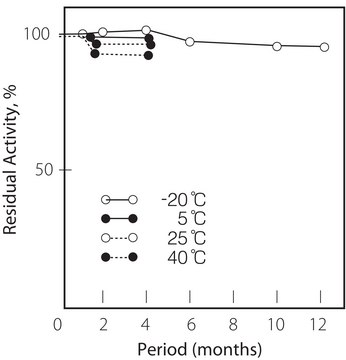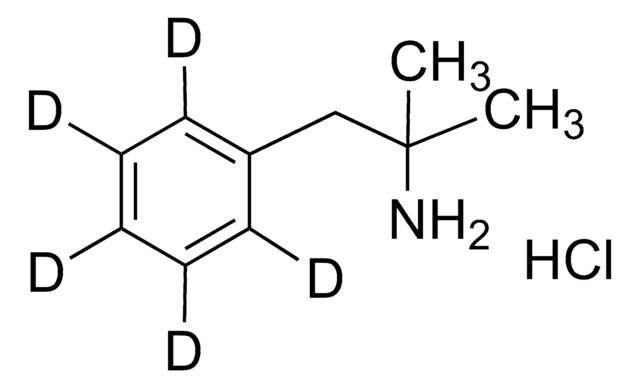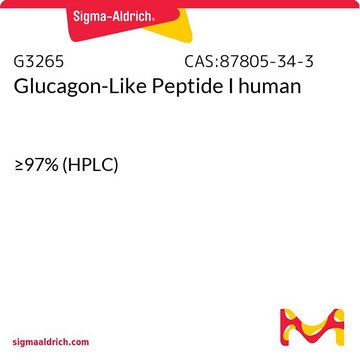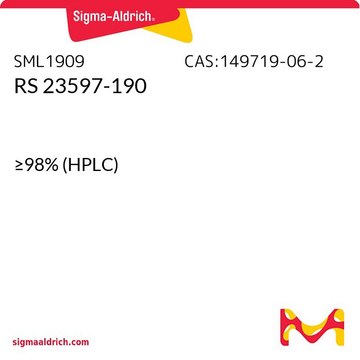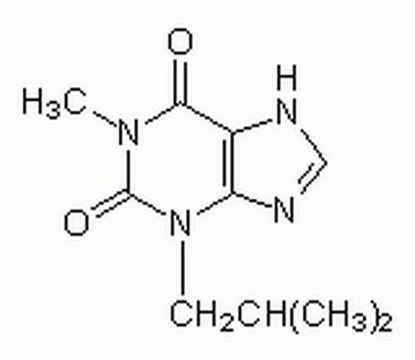S7897
Sarcosine Oxidase from Bacillus sp.
lyophilized powder, 25-50 units/mg solid
Synonym(s):
Sarcosine: oxygen oxidoreductase (demethylating)
Sign Into View Organizational & Contract Pricing
All Photos(1)
About This Item
Recommended Products
form
lyophilized powder
Quality Level
specific activity
25-50 units/mg solid
mol wt
44 kDa
storage temp.
−20°C
General description
Monomeric sarcosine oxidase (MSOX) is a flavoenzyme that catalyzes the oxidative demethylation of sarcosine (N-methylglycine) to yield glycine, formaldehyde, and hydrogen peroxide. Monomeric sarcosine oxidase can oxidize other secondary amino acids such as N-methyl-L-alanine, N-ethylglycine, and L-proline.
Sarcosine oxidase is a 44 kDa protein with covalently bound 1 mol of flavin adenine dinucleotide (FAD). It belongs to the family of amino acid oxidases with bound FAD.
Application
Sarcosine oxidase from Bacillus sp. has been used as a positive control for detection of proteins with covalently bound flavin adenine dinucleotide (FAD) by UV. It has also been used in co-immobilization with other enzymes on platinum electrode for preparation of creatinine biosensor.
Sarcosine oxidase has been used in a study as part of a multienzyme cascade, that when immobilized constructed amperometric biosensors. Sarcosine oxidase has also been used in a study to investigate oxidation of amines by flavoproteins.
Unit Definition
One unit will form 1.0 μmole of formaldehyde from sarcosine per min at pH 8.3 at 37 °C.
Physical form
No stabilizers added
Signal Word
Danger
Hazard Statements
Precautionary Statements
Hazard Classifications
Resp. Sens. 1
Storage Class Code
11 - Combustible Solids
WGK
WGK 1
Flash Point(F)
Not applicable
Flash Point(C)
Not applicable
Personal Protective Equipment
dust mask type N95 (US), Eyeshields, Gloves
Regulatory Information
常规特殊物品
Choose from one of the most recent versions:
Certificates of Analysis (COA)
Lot/Batch Number
Don't see the Right Version?
If you require a particular version, you can look up a specific certificate by the Lot or Batch number.
Already Own This Product?
Find documentation for the products that you have recently purchased in the Document Library.
Optimization of the production of Chondrus crispus hexose oxidase in Pichia pastoris
Wolff AM, et al.
Protein Expression and Purification, 22(2), 189-199 (2001)
Rastislav Monošík et al.
Analytical biochemistry, 421(1), 256-261 (2011-11-10)
Amperometric biosensors based on gold planar or nanocomposite electrode containing multiwalled carbon nanotubes for determination of glycerol were developed. The biosensors were constructed by immobilization of a novel multienzyme cascade consisting of glycerol kinase/creatine kinase/creatinase/sarcosine oxidase/peroxidase between a chitosan "sandwich."
Paul F Fitzpatrick
Archives of biochemistry and biophysics, 493(1), 13-25 (2009-08-05)
Many flavoproteins catalyze the oxidation of primary and secondary amines, with the transfer of a hydride equivalent from a carbon-nitrogen bond to the flavin cofactor. Most of these amine oxidases can be classified into two structural families, the D-amino acid
Handbook of Flavoproteins: Oxidases, Dehydrogenases and Related Systems, 196-196 (2012)
Matthew J Wargo et al.
Journal of bacteriology, 190(8), 2690-2699 (2007-10-24)
Glycine betaine (GB), which occurs freely in the environment and is an intermediate in the catabolism of choline and carnitine, can serve as a sole source of carbon or nitrogen in Pseudomonas aeruginosa. Twelve mutants defective in growth on GB
Our team of scientists has experience in all areas of research including Life Science, Material Science, Chemical Synthesis, Chromatography, Analytical and many others.
Contact Technical Service